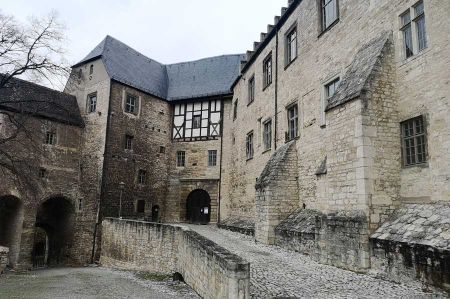Palace complex of Neuenburg near Freyburg on the Unstrut
- Written by Portal Editor
The dark gray clouds on the way to Freyburg to Neuenburg Castle indicated snowfall, but it had stayed dry until our arrival at the Unstrut Bridge.
So our first way towards the city center led us over the Unstrut bridge with its lock and the imposing fish ladder, before we went up to the ridge to the castle, past the museum of Turnvater Jahn. However, the rather washed-out path up to the castle via partly strongly offset steps should be approached with caution.
Neuenburg Castle is a hilltop castle complex on the spur-like foothills of a plateau above the eastern bank of the lower Unstrut. Below the castle in the north is the small winemaking town of Freyburg, which in turn is about seven kilometers north of Naumburg (Saale) and a station on the Romanesque Road. The castle is managed by the Kulturstiftung Sachsen-Anhalt as owner.
Neuenburg - remains of walls date back to 12th century
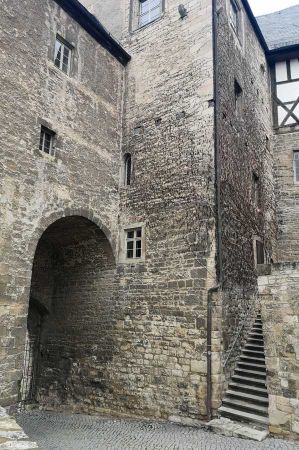 Neuenburg Castle is one of the oldest and most important castles of the former Landgraves of Thuringia. For Saxony-Anhalt, these are the only reliably verifiable above-ground stone buildings from the first half of the 12th century on castles. But the large number of preserved masonry from the end of the 11th to the beginning of the 13th century is also of great importance beyond central Germany. A special architectural gem is the double chapel built around 1180 with its unusual architectural decoration.
Neuenburg Castle is one of the oldest and most important castles of the former Landgraves of Thuringia. For Saxony-Anhalt, these are the only reliably verifiable above-ground stone buildings from the first half of the 12th century on castles. But the large number of preserved masonry from the end of the 11th to the beginning of the 13th century is also of great importance beyond central Germany. A special architectural gem is the double chapel built around 1180 with its unusual architectural decoration.
The castle is clearly divided into two parts: on the one hand the main castle with the so-called castle building and the kitchen master's office and on the other hand the older outer castle, which is framed by gallery wings.
The castle is closely linked to the history of the Ludowingers, who are believed to have come to Thuringia from Main Franconia in the 1030s.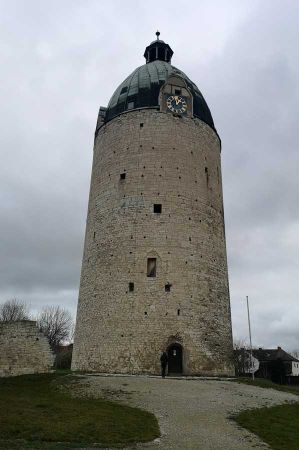 The area around Freyburg and Naumburg shortly after 1085 was handed over to Ludwig the Springer due to his marriage to Adelheid († 1110), the widow of the murdered Count Palatine Friedrich III. von Goseck, who had built the New Castle here a little later. In doing so, he substantially consolidated his new position in the Saale-Unstrut area.
The area around Freyburg and Naumburg shortly after 1085 was handed over to Ludwig the Springer due to his marriage to Adelheid († 1110), the widow of the murdered Count Palatine Friedrich III. von Goseck, who had built the New Castle here a little later. In doing so, he substantially consolidated his new position in the Saale-Unstrut area.
Until the dynasty died out in 1247, Neuchâtel was an important and at times even the largest castle of the Landgraves of Thuringia, one of the most influential families of the Holy Roman Empire.
In addition to Landgravine Elisabeth of Thuringia, Neuenburg also housed Emperor Friedrich Barbarossa within its walls. The poet Heinrich von Veldeke completed his Eneasroman there around 1185.
The Albertine Electorate of Saxony takes over the castle
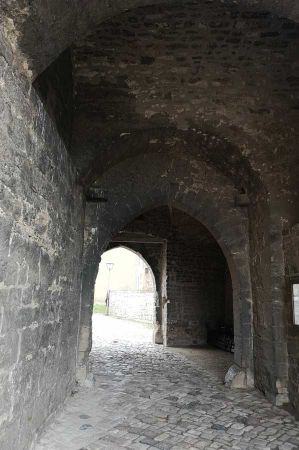 After the last Ludowingers died, Neuenburg came into the possession of the Margraves of Meißen from the Wettin family and initially lost its importance. It was not until Duke Wilhelm III. from Saxony (1445–1482) began reconstructing again around 1440. Presumably he wanted to grant Neuenburg a more important residence function, which he did not realize. When Leipzig was divided in 1485, Neuenburg came together with the city and the Freyburg office to the Albertine line of the House of Wettin. After the Schmalkaldic War in 1547 it belonged to the Albertine Electorate of Saxony. Elector August of Saxony had the complex converted into a hunting lodge in the middle of the 16th century. It also fulfilled this function from 1656 to 1746 for the dukes of Saxony-Weißenfels and the Saxon elector Friedrich August II. (1746–56). With his death, Neuenburg lost its importance for the Electoral Saxon court. It was handed over to the state administration in 1770.
After the last Ludowingers died, Neuenburg came into the possession of the Margraves of Meißen from the Wettin family and initially lost its importance. It was not until Duke Wilhelm III. from Saxony (1445–1482) began reconstructing again around 1440. Presumably he wanted to grant Neuenburg a more important residence function, which he did not realize. When Leipzig was divided in 1485, Neuenburg came together with the city and the Freyburg office to the Albertine line of the House of Wettin. After the Schmalkaldic War in 1547 it belonged to the Albertine Electorate of Saxony. Elector August of Saxony had the complex converted into a hunting lodge in the middle of the 16th century. It also fulfilled this function from 1656 to 1746 for the dukes of Saxony-Weißenfels and the Saxon elector Friedrich August II. (1746–56). With his death, Neuenburg lost its importance for the Electoral Saxon court. It was handed over to the state administration in 1770.
With the resolutions of the Congress of Vienna in 1815, the buildings and properties passed into the hands of the Prussian state. At this time, Neuchâtel Castle began to become a popular destination.
The opening of Iron Curtain makes the castle an attractive place
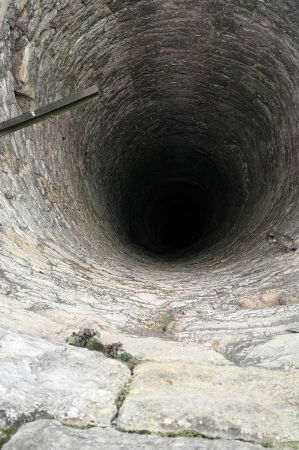 The Neuenburg Castle Museum was closed from 1970 to 1989, but the castle courtyards remained accessible. After the political change, the decay could be stopped through great government and private commitment and the castle was expanded again into an attractive place of experience. Since 1990 it has been used as a museum and for dining facilities. In 1997 the property became the property of the Castle and Gardens Foundation of the State of Saxony-Anhalt, which is now responsible for maintaining the building.
The Neuenburg Castle Museum was closed from 1970 to 1989, but the castle courtyards remained accessible. After the political change, the decay could be stopped through great government and private commitment and the castle was expanded again into an attractive place of experience. Since 1990 it has been used as a museum and for dining facilities. In 1997 the property became the property of the Castle and Gardens Foundation of the State of Saxony-Anhalt, which is now responsible for maintaining the building.
Even if it was not possible to visit the interior of Neuenburg Castle at the moment due to the corona pandemic, the tour along the mighty castle walls is already impressive. The very deep fountain is particularly impressive, as it descends more than 100 meters. In other words: even if the interior is closed, it is worth a visit.
Please read as well:
The ruins of the Tolkmar Kalesi near Silifke
Barbarossa and the myths about his death
-
 Neuenburg Castle at Freyburg on Unstrut river
Neuenburg Castle at Freyburg on Unstrut river
Neuenburg Castle at Freyburg on Unstrut river
Neuenburg Castle at Freyburg on Unstrut river
-
 Neuenburg Castle at Freyburg on Unstrut river
Neuenburg Castle at Freyburg on Unstrut river
Neuenburg Castle at Freyburg on Unstrut river
Neuenburg Castle at Freyburg on Unstrut river
-
 Neuenburg Castle at Freyburg on Unstrut river
Neuenburg Castle at Freyburg on Unstrut river
Neuenburg Castle at Freyburg on Unstrut river
Neuenburg Castle at Freyburg on Unstrut river
-
 Neuenburg Castle at Freyburg on Unstrut river
Neuenburg Castle at Freyburg on Unstrut river
Neuenburg Castle at Freyburg on Unstrut river
Neuenburg Castle at Freyburg on Unstrut river
-
 Neuenburg Castle at Freyburg on Unstrut river
Neuenburg Castle at Freyburg on Unstrut river
Neuenburg Castle at Freyburg on Unstrut river
Neuenburg Castle at Freyburg on Unstrut river
-
 Neuenburg Castle at Freyburg on Unstrut river
Neuenburg Castle at Freyburg on Unstrut river
Neuenburg Castle at Freyburg on Unstrut river
Neuenburg Castle at Freyburg on Unstrut river
-
 Neuenburg Castle at Freyburg on Unstrut river
Neuenburg Castle at Freyburg on Unstrut river
Neuenburg Castle at Freyburg on Unstrut river
Neuenburg Castle at Freyburg on Unstrut river
-
 Neuenburg Castle at Freyburg on Unstrut river
Neuenburg Castle at Freyburg on Unstrut river
Neuenburg Castle at Freyburg on Unstrut river
Neuenburg Castle at Freyburg on Unstrut river
-
 Neuenburg Castle at Freyburg on Unstrut river
Neuenburg Castle at Freyburg on Unstrut river
Neuenburg Castle at Freyburg on Unstrut river
Neuenburg Castle at Freyburg on Unstrut river
https://www.alaturka.info/en/germany/saxony-anhalt/5264-the-palace-complex-of-neuenburg-near-freyburg-on-the-unstrut#sigProId1f737eeea8
